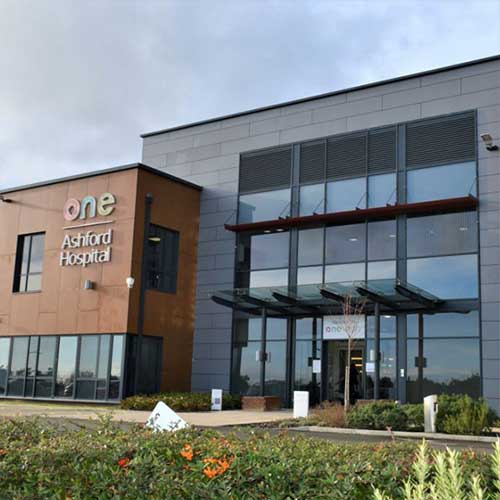Bunion Surgery (Bunionectomy)
Bunions are hard lumps that form on the side of your feet. Bunions can make walking around or even wearing shoes extremely uncomfortable and are often caused by ill-fitting footwear. Bunions are sometimes associated with arthritis that develops at the joint of your big toe.
Doctors may use the medical term ‘Hallux Valgus’ to describe the turning of your big toe joint with a bunion.
‘Hallux’ -your big toe
‘Valgus’ – pointing towards the other toes on that foot
Treatment for the condition is available at One Ashford Hospital in Kent and One Hatfield Hospital in Hertfordshire.
Causes of Bunions
The exact cause of bunions is unknown, but there are factors that can increase your risk of developing them, including:
- Genetics (bunions can run in families)
- Gender (you are more likely to develop bunions if you are a woman)
- Joint affecting conditions (such as rheumatoid arthritis)
- The way you walk
- Types of shoes you wear (narrow or high heeled shoes will put extra strain on your bones and muscles in your foot)
- Other medical conditions (gout, stroke, an old foot injury)
Symptoms of Bunions
If you are experiencing no painful symptoms, bunions do not always require medical treatment. In some cases, people do not notice any symptoms from bunions; however, if you do think you may have a bunion, look out for the following:
- Pain in the joint of your big toe
- A swollen big toe
- Your big toe is pointing towards your other toes
- Hard, red or swollen skin over the lump
- Pain along the side or bottom of your foot (made worse by walking and wearing shoes)
- When a bunion is developing, your big toe starts to slant towards your second toe. Your big toe may also turn so that the toenail is facing your other foot, instead of facing up. As your big toe bends in the direction of the other toes, the bone at its base is pushed out to the side, sticking out and rubbing on your shoe.
Diagnosis of a Bunion
In order to determine if you have a bunion, your doctor will take a full medical history from you, including when you first noticed the bunion, severity of pain, particularly when and where you place pressure on it. They will look for an angular, bony bump on the side of the foot at the base of the big toe. It will point in the direction of your smallest toe. As bunions form slowly over time, often years, there will often be hardened skin or a callus covering it. They may start with being more of an annoyance then causing a great deal of pain, but they can start to hurt and lead to further complications.
Treatment for Bunions
There are various ways you can manage the pain associated with bunions before surgical options are considered; however a Bunionectomy – bunion surgery – is the only way to remove them completely.
Before considering bunion surgery, you can relieve pain by:
- Cushioning them with padding or using wide-soled shoes
- Using an ice pack on the bunion for 5 minutes (ice can damage skin so wrap whatever you use in a towel)
- Bunion pads (you can find them in pharmacies)
- Over the counter painkillers
- Adopting a healthy lifestyle (try to lose weight if you are overweight)
Bunion removal surgery is known as a Bunionectomy. The operation is completed on a day case basis and takes roughly 30 minutes, performed under local or general anaesthetic. Your surgeon will employ a variety of methods to ensure your bunions are removed correctly, including the release or tightening of ligaments, realigning the big toe, removal or realignment of the bones in your foot or straightening the smaller toes. Some of the most common types of bunion removal surgery are the following:
Osteotomy
This involves your surgeon cutting you big toe joint and realigning it to its normal position.
Exostectomy
Your surgeon will remove your bunion from the joint without performing an alignment.
Arthrodesis
Your surgeon will replace the damaged joint with metal plates or screws in order to correct the deformed toe.
Following the Bunionectomy surgery, you will need to wait for the effects of the anaesthetic to wear off. If you have had a general anaesthetic, arrange for someone to drive you home and stay with you for a couple of days.
Your foot will be bandaged, and possibly put in a cast, following the operation. A nurse or physiotherapist may come and see you to show you how to manoeuvre without hurting yourself, possibly offering crutches and teaching you how to use them. You will also be booked in for a follow-up appointment to see how well your foot is healing.
Bunion surgery is not recommended for cosmetic reasons; only when the pain interferes with your day-to-day life.
Post-Operative Recovery
Following your Bunionectomy, you will be advised to stay off your feet as much as possible, preferably for 2 weeks in order to aid your recovery. You will be able to put weight onto your other foot that has not been operated on, but it is important to rest with your foot on a stool for the first few weeks, as this will help reduce the swelling.
How quickly you return to work depends on your job, and how much standing is required of you. The recommended time is 6-8 weeks before returning, in order to gain a full recovery. If your job involves driving (or you drive for daily commutes), make sure you check with your doctor and car insurance about when you can start again as you may not be able to wear normal footwear for a few months.
You may take over the counter pain relief but make sure you check with your doctor.
Complications
All surgical procedures include a certain degree of risk. The most likely complications to occur in a Bunionectomy are infection, pain, nerve damage to the operated foot, and the chance that the bunion will return. Complications can include:
- A stiff toe. Although this doesn’t bother most people, it can cause problems for athletes or dancers
- A numb toe. This is caused by the nerves in your toe being injured
- An abnormal toe position. This results in your big toe healing out of line and bending outwards or upwards. It may also be slightly shorter than your other toes
Serious complications include:
- Fever
- Increased persistent pain
- Redness around your bandage
- Inflammation or pain in your calf muscle of your leg
- Discharge from your wound
Outlook After Bunion Surgery
The Bunionectomy procedure is highly successful, but it is important that you look after your foot to ensure it heals correctly. In future, it is recommended that you avoid ill-fitting shoes which are too narrow as this will help prevent bunions from reoccurring at a later date.
Need Help?
At One Healthcare we can book you in to see a specialist Podiatric or Orthopaedic surgeon, usually within 48 hours, for an initial consultation. Bunion surgery (Hallux Valgus/Bunionectomy) is available at One Ashford Hospital in Kent and One Hatfield Hospital in Hertfordshire.
You can use your private medical insurance or pay for your Bunion Surgery (Bunionectomy) treatment. We offer competitive, fixed price packages. If you are using your health insurance, please contact your insurer first for approval and let them know you’d like to be treated at either the One Ashford Hospital or One Hatfield Hospital.
Why One Healthcare
- Modern purpose-built hospital opened in March 2016 (Ashford) December 2017 (Hatfield)
- Fast access to diagnostics including MRI, X-ray and Ultrasound
- 0% and low finance options**
- Private, spacious, en-suite rooms
- Specialist Physiotherapy and nursing teams
- Little or no waiting time
- ‘Ultra clean air’ theatres
- Freshly prepared food
- Calm, dignified experience
**Terms and conditions apply
Contact us and find out more
If you live in and around the Kent area and would like to visit our One Ashford Hospital please click here
If you are based in and around Hertfordshire and would like to visit the One Hatfield Hospital please click here.
Consultant Specialists
Contact the Hospital About Bunion Surgery (Bunionectomy)
Choose a Hospital

01233 423 000
One Ashford, Kennington Road, Willesborough, Ashford, Kent, TN24 0YS
One Ashford Hospital

 One Ashford
One Ashford One Hatfield
One Hatfield